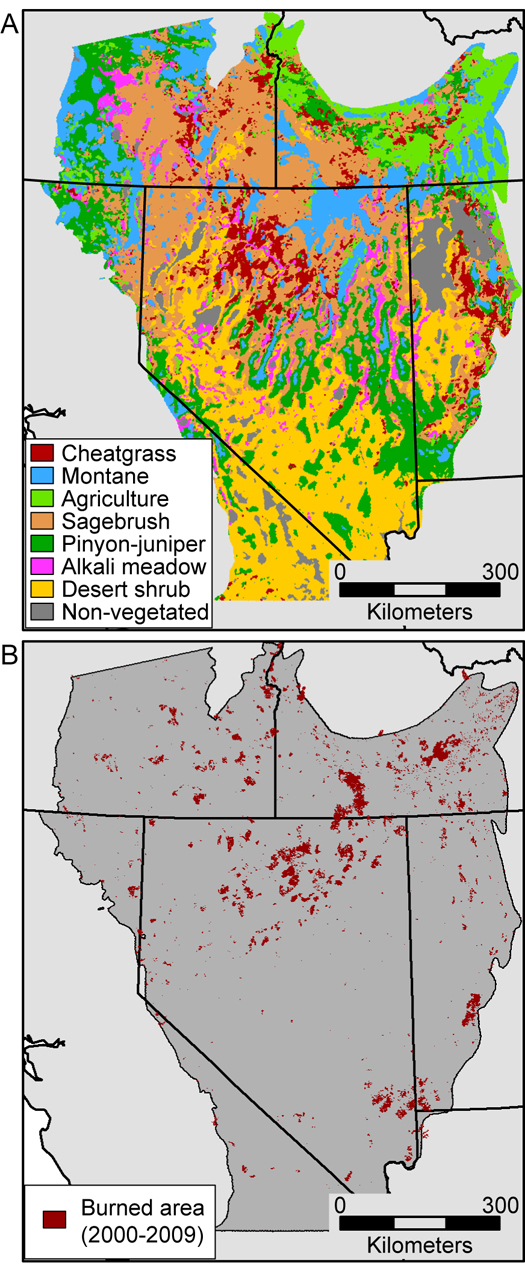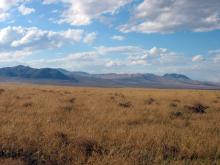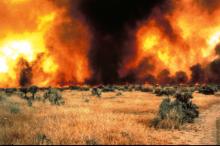


An invasive grass species may be one reason fires are bigger and more frequent in certain regions of the western United States, according to a team of researchers that includes scientists from UC Santa Barbara.
The researchers used satellite imagery to identify cheatgrass, a plant species accidentally introduced by settlers in the west during the 1800's, in a disproportionately high number of fires in the Great Basin, a 600,000-square-kilometer arid area of the west that includes large sections of Nevada, as well as parts of Utah, Colorado, Idaho, California, and Oregon.
"Over the past decade, cheatgrass fueled the majority of the largest fires, influencing 39 of the largest 50 fires," said Jennifer Balch, former postdoctoral associate at UC Santa Barbara's National Center for Ecological Analysis and Synthesis (NCEAS). Balch is now an assistant professor in Penn State's Department of Geography and Earth and Environmental Systems Institute. "That's much higher than what it should be when you consider how much of the Great Basin that cheatgrass covers," she added.
The average size of the fires in cheatgrass grasslands, which dominate only about 6 percent of the Great Basin, was significantly larger than the average fire in most regions dominated by other vegetation, including pinyon-juniper areas, montane shrubland, and agricultural land.
In addition to targeting the influence of cheatgass on major fires, the researchers, who reported their findings in the online version of Global Change Biology, also found that the plant may play a role in increasing the frequency of fires, said Balch. "From 2000 to 2009, cheatgrass burned twice as much as any other vegetation," she said.
"Although we have long suspected that invasive annual grasses can promote increased occurrence of fire, it is very hard to get the data to show this," said Carla D'Antonio, Schuyler Professor of Environmental Studies at UCSB, and one of the study's co-authors. "Our study provides quantitative data showing that fires more often than expected start in invasive annual grass vegetation and spread from there into adjacent vegetation."
One of the consequences of more widespread cheatgrass fires is that landscapes dominated by the grass have a shorter fire-return interval –– the time between fires in a region –– of 78 years, compared to other species like sagebrush, which has a 196-year fire return interval.
"What's happening is that cheatgrass is creating a novel grass-fire cycle that makes future fires more likely," said Balch, who started this study when she was at NCEAS. "Fire promotes cheatgrass and cheatgrass promotes fires."
The ability of cheatgrass to rapidly spread and fill in the ground between other plant species may be one reason the plant is involved in larger and more frequent blazes, said Balch, who worked with co-authors D'Antonio; Bethany Bradley, assistant professor of environmental conservation, University of Massachusetts-Amherst; and José Gómez-Dans, research associate in the department of geography and the National Centre for Earth Observation, University College London.
Balch said the cheatgrass-influenced fires create a difficult management challenge. The fires can threaten agricultural lands and, since more people are building homes in the west, residential areas as well as habitat for threatened native wildlife such as the greater sage-grouse.
While cheatgrass-driven fires have been recognized for decades, remote sensing technology has allowed the researchers to take a regional approach to assessing the problem. They compared burned area detected by NASA's Moderate Resolution Imaging Spectroradiometer between 2000 to 2009 to regional land cover maps that included cover of cheatgrass.
"Historically, the way remote sensing worked, you could only tell the difference between broad land cover classes such as trees versus wetlands, for instance," Bradley said. "It is very difficult to capture those details at the species level."
However, by noticing what conditions favor the growth of certain species, the researchers were able to use the satellite imagery to better pinpoint their growth. For instance, cheatgrass grows during wet periods, while many other species do not, Bradley said.
"What you end up seeing is that most years when it is dry, the cheatgrass doesn't grow much," said Bradley. "But when there are wet seasons that occur due to the El Nino cycle, cheatgrass cover is very dense and continuous."
Bradley added that this is a concern because cheatgrass now dominates more than 40,000 square kilometers, an area that is more than 100 times the size of Salt Lake City, Utah.
According to the researchers, those changes in the vegetation, then, can be detected in the satellite images. "Being able to detect cheatgrass and burns really enabled us to ask the important question: ‘How does an invasive plant change fire activity across the entire Great Basin?' " Balch said.
The National Science Foundation and NCEAS supported this work.
† Bottom image:
(A) Cheatgrass dominates 40,000 square kilometers of the Great Basin, compared with other vegetation types
(B) Of the total burned area detected by the NASA-MODIS satellite from 2000-2009, over 5,000 square kilometers of cheatgrass-dominated lands burned roughly more than double the area that burned in any other vegetation.
Credit: Bethany Bradley, UMASS-Amherst
Related Links



